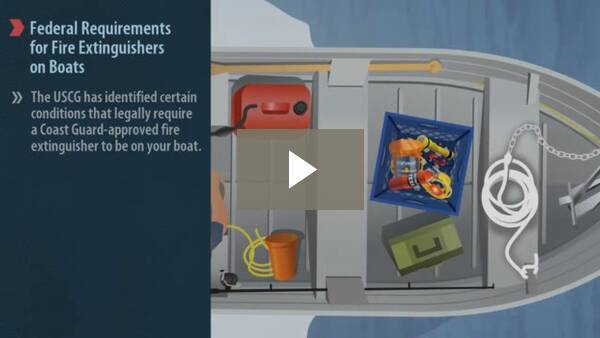Fire Extinguisher Requirements for Boats
Most powerboats operate using gasoline, which would explode if it came into contact with a flame. Fire emergencies will always be a risk for boaters, but fires can be fought with the right equipment.
Although some boat types are not required to carry a fire extinguisher, you should always have one on board your boat.
The USCG has identified certain conditions that legally require a Coast Guard-approved fire extinguisher to be on your boat. Does your boat have any of these features?
- Enclosed living and cooking spaces?
- Permanently installed fuel tanks (or tanks that are too heavy to lift)?
- Enclosed engine compartments?
- Seat compartments where engine tanks may be stored?
- Double bottoms not permanently sealed to the hull (or not completely filled with flotation material)?
If you answered ‘YES’ to any one of these features, you are required to have a Coast Guard-approved extinguisher on your boat.
Types of Fires and Fire Extinguishers
All fire emergencies are extremely dangerous. Knowing about the different types of fires will help you to prevent fire emergencies and better prepare you to fight them.
Fire extinguishers are classified by a letter and number system. The letters describe the different types of fires that the extinguisher should be used for.
For example:
Type A:
This fire is caused by combustible solids (like wood or paper).
Type B:
This fire is caused by flammable liquids (like gasoline, oil or grease).
Type C:
This fire is caused by electrical problems (like a spark in the engine).
Type D:
This fire is caused by combustible metal materials (like titanium).
The number identifies the amount of ‘agent’ that’s inside the extinguisher. ‘Agent’ is the material that puts out the fire. The higher the number, the greater the amount of fire-fighting agent in the device. For example, the B-III fire extinguisher is capable of putting out a bigger fire than the B-I fire extinguisher.
Your Fire Extinguisher Requirements:
If your boat is required to have an extinguisher, you’ll need a proper mounting bracket to hold it in place. Fire extinguishers (and all safety equipment) should be kept in an easily accessible place, like the steering area, where they will be near the operator. Be sure to mount your extinguisher away from areas where a fire could start, like the engine area.Where to Locate Your Fire Extinguisher
Note: Water can put out a Type A fire, but if there is a Type B, C or D fire, water should never be used. Water can cause flammable liquids to spread rather than putting the fire out. Additionally, water could create an electrocution hazard.
Maintaining Your Fire Extinguisher
Monthly inspections are necessary to keep your extinguisher working properly. To properly inspect and maintain your extinguisher, you should:
- Have a qualified professional maintain, service and recharge your fire extinguishers according to the manufacturer’s instructions.
- Look at the gauge and ensure that the fire extinguisher is fully charged.
- Check the hoses and seals for any cracks or signs of damage.
- Weigh the extinguisher to check that it meets the weight requirements on the label.
- Recharge the fire extinguisher whenever necessary.









